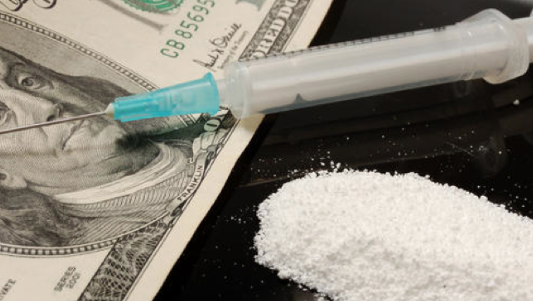By Mike Rutledge
NKyTribune Contributor
When heroin-addicted inmates start leaving the Kenton County Detention Center injected with a medication that prevents them from getting high from heroin and connected to treatment that can help them battle their addictions, Kim Moser and Kirk Kavanaugh are two of the people who made that happen.
When a public education campaign launches around the first of the year to inform the region about the dangers of heroin, Moser and Kavanaugh will have led that effort as well.
And when a new program enters Northern Kentucky to help heroin-addicted pregnant women deliver healthy babies and straighten out their lives, Moser and Kavanaugh will have played a major part in that.
Moser, a registered nurse with lobbying experience, and Kavanaugh, an attorney and former federal probation/parole officer in Indiana, together make up the Northern Kentucky Office of Drug Control Policy. Moser is the director, and Kavanaugh is deputy director.

You could consider them Northern Kentucky’s drug czars, tasked with a two-to-three-year mission of eliminating barriers large and small that have prevented Northern Kentucky’s estimated 5,000 heroin addicts from getting help they need to try to escape the drug’s grasp.
Their office officially launched July 1, but they were working before then to help start Kenton County’s 100-bed treatment facility – 70 for men, 30 spots for women – that gives inmates a three levels of intervention therapy, varying from 30 days to six months.
Employed by the Northern Kentucky Area Development District, they are funded by the counties of Kenton, Campbell and Boone, plus the R.C. Durr Foundation. Kenton, Boone and the foundation each provided $40,000 for the first year, while Campbell provided $20,000 plus office space, phones and office supplies.
“Our goal is to move this process very quickly,” Kavanaugh said in a recent interview. “The time for talking and discussion … we need action now.”
The pair meet at least twice monthly with county leaders. They also have met with the three county fiscal courts, the mayors of Kenton and Campbell counties, the city of Florence, and judges who handle criminal cases. They’ve also visited area jails and talked with jailers and judges about problems they face in connecting addicts to voluntary treatment.
Among those obstacles is a lack of sufficient treatment-center beds, but there are numerous other issues that are barriers.
“We’ve met across the river, regionally, because we feel this is a regional issue,” Kavanaugh said. “We’ve met with Talbert House, Greater Cincinnati Behavioral Health, First Step Home, Addiction Services Council and the Hamilton County administrator.”
When U.S. Sen. Rand Paul (R-Kentucky) was in town Monday, Moser met with him to discuss a seemingly small issue that is preventing many local addicts from receiving medically assisted treatment using the drug Suboxone.

Suboxone suppresses withdrawal symptoms and cravings for heroin and other opioids, and does not cause euphoria in the user. The problem is, under federal regulations written in 2002, doctors are only allowed to treat 30 Suboxone patients their first year of prescribing it, and 100 the second year.
When meeting with Sen. Paul, Moser told him doctors “can only have 30 patients in their first year. Which is nothing,” she said. “I mean, we have potentially 5,000 heroin addicts here, in Northern Kentucky. The Methodone clinic is seeing 1,200 a day. So we know that we have a huge problem but we don’t have enough prescribers.”
She said the senator ”is extremely helpful on this. He wants to raise the limit.”
There’s another drug, called Vivitrol, that gives officials hope will help inmates can avoid overdosing when they leave jail. It’s an injection that lasts about a month and prevents users from getting high from opioids.
“It works by decreasing cravings and you can’t get high if you’re taking it,” Moser said. “So we’re hoping that if we get the inmates through some sort of treatment in jail and then give them a Vivitrol shot right before they’re released, that it will bridge that period of time between jail and getting into an intensive treatment facility, and they won’t go right out and use again.”
The days immediately after release are particularly dangerous for heroin addicts, says Kenton County Jailer Terry Carl, who hopes providing inmates the injections before their release can bridge the gap while they re-enter the outside world.
Sometimes, their dealers pick them up and reintroduce them to the drugs, Moser said. Often, they overdose because they haven’t been using for a while and their tolerance to the drug has been reset, but they use the same dose as before.
“The ones that we send out of here with Vivitrol, we’re going to drive them personally to St. Elizabeth’s and turn them over to St. E’s program, intensive outpatient, plus a continuation of the Vivitrol,” Carl said.
Moser and Kavanaugh set three primary goals for their first year:
Facilitating the hiring of a jail navigator to help with Kenton County’s jail treatment program, with hopes of extending similar programs to other jails.
Creating a Greater Cincinnati/Northern Kentucky public education program about heroin and opioids. As part of that, they plan to create a one-stop hotline that can connect people with a variety of services.
Creating a support network for pregnant women to help them deliver healthy babies while using treatment options and medications that are safer than heroin.
* * * * *
You may be interested in this publication offered by the Kentucky Office of Drug Control Policy:
A parent’s guide to the legal drugs kids are using and abusing






















Great Article. There is only one problem I see with this and that is: Soboxone is addictive and the user can get high from it. I work with many recovering addicts. I have been on the front lines in treatment centers, jails, and half way houses. All of the addicts say the same thing. Suboxone was a good try but it is just as bad as methodone. I have heard many stories about addicts getting their Soboxone prescription filled and either using it to get high by smoking it, swallowing it(taking many pills at one time), and injecting it. They also sell it to other users for anywhere from $5-$10 a pill! There are other ways to fight this battle and those ways do not include putting an addict on another addictive drug. I will continue the fight from the front lines and in the streets. We all have to do our part to eradicate it. I am tired of seeing my friends die! God Bless!